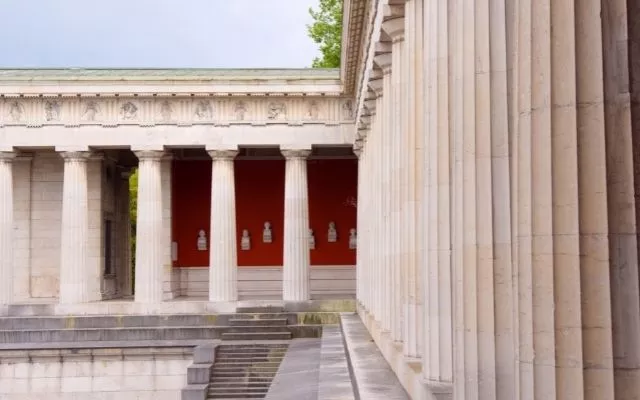The Munich Hall of Fame – Ruhmeshalle as it is called in German – is yet another Munich Monument commissioned by King Ludwig I to facilitate his vision of Munich becoming a new “Athens on the Isar”.
The Ruhmeshalle Munich was Built as part of the nationalistic Germanic drive undertaken by King Ludwig, which included the construction of dozens of monuments and statues in the city in the early to mid-19th century.
Sadly, this Munich Monument was a little neglected on our last visit but apparently, it has seen a little TLC since then which is great to hear.
Regardless, the Munich Hall of Fame remains an important part of Munich’s History from Ludwig’s reign, and if visiting the area around the Theresienwiese, it’s an impossible construction to miss!
Who Designed and Built the Ruhmeshalle?
Surprise, surprise, it’s that guy again. Yep, it was Ludwig’s favourite architect Leo Von Kleeze who was behind the design and oversaw its construction.
The Hall of Fame was built in the Doric Style which is to say that it was inspired by Ancient Greece, and its main design aspects were the huge columns supporting the entire construction.
Constructed entirely of Limestone from the Bavarian town of Kelheim, this monolithic colonnade is 68 metres long and 32 metres deep.
Badly damaged in World War II the Ruhmeshalle München was rebuilt between 1965 and 1972 with the surviving 67 busts, at which time 25 new busts were added.
What Exactly Is the Ruhmeshalle?
The Hall of Fame is a sort of an outdoor museum that was built specifically as a tribute to some of the most important people of Ludwig’s Kingdom.
Included in the white busts adorning its walls are prominent artists, writers, sculptures, architects, and other important peers from Bavaria. There are also many personalities included from the neighbouring regions of Swabia, Palatinate, and Franconia.
A walk through the corridors of the Ruhmeshalle is most definitely a stroll through Bavarian history.
The building’s two wings at either end of the colonnade, almost appear to stretch out like two arms in a somewhat awkward embrace of the giant bronze Bavaria Statue standing proudly in front of the Ruhmeshalle Munich.
Where Is the Ruhmeshalle and How Do I Get There?
The Ruhmeshalle is located in central Munich on the western side of the city’s Festival Grounds (The Theresienwiese).
Getting to the Hall of Fame from central Munich is very easy with the easiest way being on the Munich Underground (U-Bahn). The U5 and U4 train lines support the closest U-Bahn station to the Ruhmeshalle, that being the station of Schwanthalerhöhe.
There are also many bus services that come close to this location in the city, and should you perhaps have arrived in Munich by S-Bahn, then it’s just a fifteen-minute walk from Hackerbrücke station.
Walking from Marienplatz in the city centre to the Ruhmeshalle Munich will take 25-35 minutes depending on your fitness level and pace.
Consult one of our Munich Maps for more of an idea, or check out the Munich Public Transport Website for more details on Getting to the Munich’s Ruhmeshalle.
Opening Hours of the Ruhmeshalle
As this is an open-air monument it actually doesn’t really close. Expect it to be quiet here where you can spend a half-hour in solitude. Except at Oktoberfest time obviously when the thousands of people in the area are interested more in beer than in sightseeing!

Ruhmeshalle München: Why You Should Visit!
All around the world, there are many monuments, buildings, and tribute memorials such as this one with most dedicated to politicians and statesmen.
The big difference with the Ruhmeshalle is that it highlights the achievements of scientists and artists. The people who built the foundations of modern Bavarian culture here in Germany.
Until the year 2000, only the busts of men were present, but some brilliant women have since been honoured in the Hall of Fame such as writer Lena Christ and the famous actress Clara Ziegler.
Do yourself a favour and head on down to the Bavaria Ruhmeshalle at the Theresienwiese yourself, and check out the Munich Hall of Fame and the Statue of Bavaria at the same time.
For further information on the site, and to perhaps obtain a complete list of whose busts are included in the building, please contact the administrative offices of the Bavarian Palace Department which oversee the operations of many Munich Monuments.
Thanks for reading and we hope you enjoy visiting the Ruhmeshalle here in Munich. Have a great day!

